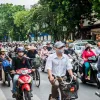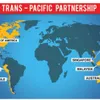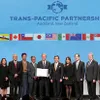FTAs expose agri sector to cold winds of change
Q: A number of free trade agreements (FTAs) that Vietnam join are set to come into force. What agreements has Vietnam made with its FTA partners to protect the local agriculture sector? What should the government do to support the sector?
A: While many countries spent large amounts of money thoroughly analysing potential gains and losses before their FTA negotiations, Vietnam made its position clear and decided on some smart moves to protect its agricultural sector in spite of the country’s smaller financial capacity.
Agriculture was the pioneer sector in preparation for the effectiveness of FTAs, including the Trans-Pacific Partnership (TPP).
Once a consensus between Vietnam and the other 11 TPP members was reached, the agricultural sector held a large-scale workshop to assess the advantages and disadvantages as well as other possible impacts of the TPP on the sector. The event was attended by leaders of the Ministry of Agriculture and Rural Development, the US ambassador, the head of the Vietnamese TPP negotiation delegation Tran Quoc Khanh, business associations, and representatives of provinces, amongst others.
The workshop also focused on measures to raise local awareness about increasing product quality, the development of agricultural areas in provinces such as Nam Dinh, Quang Ninh, Bac Kan, and the Mekong Delta, and what the sector should do in the new global economic climate.
The government needs to provide more support for the agricultural sector, particularly the livestock production industry. In my opinion, financial support is not a long-term strategy because the country cannot afford to support the sector forever. Instead, the state should offer assistance in science and technology, breeding, and quality standards, while creating favourable conditions for domestic farmers to increase innovation and ensure a healthy environment for domestic and foreign firms to compete in.

Director Nguyen Do Anh Tuan
Q: Vietnam’s agriculture sector could be negatively impacted once the FTAs take effect. What areas are most vulnerable?
A: Although Vietnam is home to rich natural resources and has abundant water for agricultural development, it is expected to face many challenges in the export of its products.
Farmers are concerned about competition from the imported products that will penetrate the domestic market when various FTAs take effect. I think that Vietnam will need to focus on solving problems with food safety and hygiene and raising the overall quality of its agricultural products in order to keep exports up.
With our export-oriented strategy driven by the abundant supply of products, any stagnation in export activities would cause a headache for the sector.
FTAs the ASEAN Economic Community will create many opportunities, but also obstacles for Vietnam’s agriculture sector. Not all agricultural fields will benefit from these deals.
The livestock production sector is the most vulnerable to increasingly deep global integration because Vietnam lacks large-scale meadows, food sources, and other necessities. Therefore, when the FTAs come into force, foreign invested companies will likely dominate the market thanks to their large financial capacity and production scale and their efficient, hi-tech operations.
For example, in 2015, the import of inexpensive poultry from the US caused a loss for Vietnamese farmers. The chicken flap was a wake-up call for Vietnam as it prepares to embrace more FTAs. It was also a good example of the difficulties Vietnamese farmers, particularly those with small household farms, could face,
Another big challenge is the quality of food. Vietnamese people currently still prefer locally-made farm products because they know the origin of the products. However, if more people are hospitalized by unsafe foods, customers will prioritize imported goods.
The fruit and vegetable industry will also not fare well. When the AEC takes effect, Vietnamese fruits and vegetables will face stiff competition from other countries, especially Thailand, whose strong mango sales once hurt farmers in the Mekong Delta, which is Vietnam’s southern fruit hub.
Q: Agriculture held just 1% of Vietnam’s total registered foreign direct investment (FDI) last year, against 2-3% in previous years. Do you think that Vietnam should focus on core sectors such as agriculture rather than entertaining illusions about developing some industries like the auto industry?
A: Vietnam is not unusual, because in many countries, agriculture is not as attractive to FDI firms as other sectors. Argentina is the only nation in the world where FDI in agriculture accounts for 5% of total FDI.
The main reason for modest FDI in this sector is not a lack of incentives, taxes, or fees, but our growth model and macroeconomic policies. In fact, while the majority of FDI flows into finance, real estate, and construction, which are the sectors where Vietnam does not have much competitive edge, FDI in agriculture has decreased. Problems with material supply, limited land sites, and weak sales are also barriers for attracting FDI in agriculture.
At a recent meeting with government leaders, senior economist Le Dang Doanh said that although Japan was capable of producing aircraft, it had never done this because of its less competitive prices.
Vietnam should therefore focus on the sectors where it has advantages in sales, competitive prices, and influence. Vietnam has three sectors with these advantages: agriculture, information technology, and tourism.
Q: Recently, there has been a trend of shifting investment to agriculture among big private domestic companies, while more foreign firms also eye agricultural investment in Vietnam. What are the sector’s future FDI prospects when various FTAs take effect? What policies should the government make to attract more FDI in agriculture?
A: There has been a movement of investment from the fields that saw hot growth-such as securities, real estate, and mining-to agriculture. This is simply due to market developments. When the short-term rapid growth of the other industries slowed, firms had to find different areas for long-term investments, which include agriculture.
Vietnam’s agriculture has more of a competitive edge in terms of input service, processing, and sale service than that of other countries, such as Thailand or Israel.
Many local groups such as Hoang Anh Gia Lai (HAGL), Vingroup, TH, and Hoa Phat are among the most successful agricultural firms. TH and HAGL have been applying Israel’s hi-tech systems in the production and development of high-quality products with strong brand names in the domestic market.
The sector also saw a number of foreign investors, especially those from Japan and multinational groups, rushing to Vietnam to invest in agriculture in order to tap into FTA benefits such as the removal of many tariffs.
In fact, agriculture in Vietnam has been assisted by new government policies such as the prime minister’s Decision 899 on agriculture restructuring, Decision 210 on incentive policies, Resolution 14 on credit support for businesses in building value chains, and the approval of the global integration strategy for agriculture, which is considered an important preparatory step for entering new global markets.
More importantly, a draft decree to attract FDI in agriculture is awaiting approval by the government and is expected to take effect soon. The involvement of FDI firms would go a long way in supporting Vietnamese agriculture.
Q: Have you ever witnessed any success stories that have made a strong impression on you?
A: Locally-owned Nafoods Group hugely boosted its presence in the international market, with the production volume of its condensed lemon product making up 10% of the world’s total. The firm now holds the biggest global market share of the product.
An Giang Plant Protection Joint Stock Company is also another good example. It has succeeded in the development of large-scale rice fields which meet the market requirements of partners in the US and Japan.
The success of these firms can be attributed to their choices in product development, good market orientation, and sci-tech applications.





